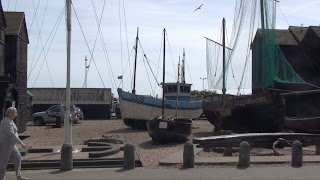Friday, May 13
It has been a lucky day. Once again the weather is clear and sunny with just a couple of small fluffy low floating cotton ball cumulus clouds to punctuate the blue skies. A leisurely breakfast overlooking the garden, and then off down winding roads of Sussex, stopping first at the waterside town of Rye. Its residents were known in the past as fishermen with a talent for smuggling on the side.
In the heart of town bumpy narrow cobblestone streets wind uphill from the old harbor. Many of the old houses are half timbered structures, the gaps between filled with wattle-and-daub covered with plaster and whitewash. At the roof peak of an old pub I see 1762 carved into the beam. Another building has a small plaque reading "rebuilt in 1686". Opposite the Mermaid Pub is a house named "The House Opposite". A block over the street running down the hill is just as narrow, lined with shops and houses just as old, but somehow looking more modern with its asphalt pavement.
The old harbor, really nothing more than bulkheads on either side of a small river no more than sixty feet wide is no longer a point of commerce. Slightly frumpy looking round bottom boats pleasure boats or those with retractable centerboards sit in the mud twenty feet below the quay waiting for the incoming tide to float them again. The active harbor is about three miles downstream where the water is consistently a bit deeper and the river a bit wider.
A short drive from Rye is the town of Iklesham overlooking soft green fields that roll down to the sea. Hidden from the main road, down a side street at the edge of town is "The Queen's Head", an old English Pub built in the early 15th Century. Dryed hops hang in bunches from old hand hewn beams that angle up to a peaked ceiling. An old bar angles across one corner of the main room, and bulls-eye windows transmit a distorted view of the world outside. We step down into a smaller side room where small dark oak beams support a low flat ceiling and take a table next to a wide fireplace. Each of us orders a different mid day dinner from the menu and a pint of nice dark ale to wash it down.
It is another short drive from Iklesham to the town of Hastings. There is still an active fishing fleet here, the only place in England where the clinker-built lapstrake round bottomed boats run directly up onto the gravel beach instead of docking. All was calm on the waterfront today, but when the surf is up it must be cause for considerable tension as each boat runs toward the beach, maintaining enough speed so that the waves will not swing the stern around, resulting in swamping or capsizing. As the bow crunches onto the gravel strand a crewman leaps off the bow with a line that is attached quickly to a cable that leads to the winch that will complete the landing. In order to launch again, a bulldozer with a special padded blade will push against the bow until the boat is re-floated.
A multitude of narrow black net drying houses perhaps twelve feet on a side and two stories tall crowd close together along the beach. There is room for a single road along the beachfront, and directly behind that eroded sandstone cliffs rise up sharply. A steep funicular railway car climbs at a forty-five degree angle up to the top of the cliff, balanced by a second car on the way down. At the top, a broad grassy ridge provides a sweeping view of the coastline to the west, past Bexhill and Eastbourne all the way to the silhouette promontory of Beachy Head jutting out into the English Channel.
Our mid-day meal had been so filling that this evening we skipped a regular dinner, opting instead for tea and a raspberry dessert.


No comments:
Post a Comment